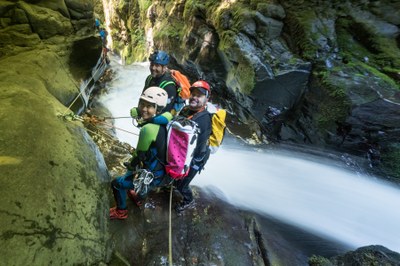
Field trip: Canyoning Assessments
Assistant Canyon Leader Assessment - Mountaineers Seattle Program Center
A 1.5 day assessment for Assistant Canyon Leader Candidates
- Sat, May 13, 2023 — Sun, May 14, 2023
- Seattle Canyoning Committee
- Canyoning
- Adults
- Challenging
- 2 (4 capacity)
- FULL (4 capacity)
- Cancellation & Refund Policy
We will confirm once we have a roster. Most likely, the Assistant Leader Assessment will start late-morning on Saturday until about 5 or 6pm, and again Sunday from 8am-2pm. To be safe, plan for 8-6 each day.
saturday afternoon
Assessment Objectives:
Students must be able to demonstrate, at minimum, sufficiency in the skills being assessed. Sufficiency = 3 on the Mastery Hierarchy: (1=failure, 2=insufficient, 3=sufficient, 4=proficient, 5=mastery).
These skills are not expected to be done quickly or perfectly, but rather showcase that students are able to demonstrate the required technical skills without assistance, and without any major safety errors. They must be executed effectively in a reasonable amount of time. Sufficiency means a student is at a suitable level of skill for independence.
Guidelines
Candidates may use any piece of equipment on their harness to complete the techniques being assessed. Additional equipment will be provided by the assessors if necessary for specific techniques.
How to Pass Each Assessment
- Complete the task without any major safety errors (errors that have a high probability of leading to serious injury or death), and with 2 or fewer minor errors (errors that, with other compounding factors, could lead to serious injury or death)
- In the event that you commit a major safety error, you will be asked to meet 1x1 with a different assessor at the end of the day (after assessments are complete), and correctly demonstrate the skill where you committed the error, and explain to the assessor the error you made, and why it’s a critical safety error. If you cannot do this, you will need to take the entire assessment again another day.
- In the event that you commit 3 or more major errors in a single assessment, you will need to re-take the entire assessment at the end of the day (after assessments are complete). If you do not pass, you’ll need to take the assessment again another day.
INDIRECT RESCUE: ROPE CUTTING (TIMED)
As the anchor manager, cut the primary rope and lower a teammate with a rescue rope. Students must approach the system with their harnesses racked as they would be normally. Time starts as soon as the student clips their lanyard into the anchor. Any safe method is acceptable (1 min. 30 sec. or under) Maximum 3 attempts.
PERSONAL MOVEMENT - QUICK-RELEASE ASCENDING SYSTEM
Ascend and convert to descent using a VT and Italian 8 on a single rope system
SAFETY MANAGEMENT
Provide a belay from the top, and then from the bottom, to protect a rappeller
GUIDED RAPPEL TEST
Rig, manage & clean a guided rappel
- Rig using an Italian 8
- Use a conveyor belt system to lower a stuck rappeller
SUNDAY MORNING
NATURAL ANCHORS
Build a series of natural anchors, including building and managing a cairn anchor
- Redundant Basket Hitch around a rock pinch
- Single strand around a tree
- Build & manage a cairn anchor
CONVERT STATIC RIGGING TO A LOWER
CONVERT RELEASABLE RIGGING TO A HAUL
PICK-OFFS
Use a VT Prusik as a pickoff strap
SUNDAY AFTERNOON
CORE SHOT MANAGEMENT
As the anchor manager, respond to a teammate communicating that there’s a core shot, manage the anchor for the remainder of the team, and manage abrasion as the last person down.
- Tie two ropes together with stacked overhand or other safe method
- Creep the rope with ropes tied together
- Isolate a core shot with a safe clip-in point
- De-rig and descend double strand to mitigate abrasion
- Pass a knot double strand on descent
- Manage ropes to keep them from twisting
RIG & MANAGE A REBELAY
Rig a rebelay, and anchor-manage at the rebelay
TWIN SYSTEMS
Rig and retrieve both twin static and twin releasable systems
- Special rigging plates (eg. Totem, double-8, etc…) are not acceptable for this assessment
LOWER JOINED ROPES PAST AN ANCHOR
While lowering a teammate, safely transfer two ropes joined together past the anchor to continue lowering.
Badges
students will earn:
Required Equipment
- Harness
- Helmet
- Adjustable Friction Canyon Descender
- 4 working Carabiners
- Alpine Canyon Draw
- VT Prusik*
- Figure-eight Descender
- Footloop
- Mechanical hand ascender
- Mechanical harness ascender/chest ascender
- Progress-capture Pulley*
- Petzl Tibloc (optional but recommended)
- Rollclip Carabiner (optional)
- Double-ended rope bag (optional)
The Mountaineers has gear to loan - please contact the leader
*Note that VT Prusik's come in 7mm and 8mm versions. Either diameter is acceptable, but should be compatible with your Progress-capture Pulley. An Edelrid Spoc can accomodate a 7mm VT, a Petzl Microtraxion can handle a minimum of 8mm. If given options, we recommend purchasing the longest VT prusik available.

 Assistant Canyon Leader
Assistant Canyon Leader